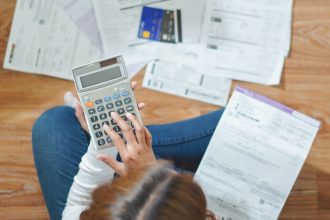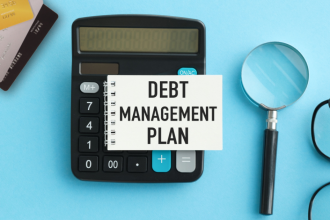THIS POST MAY CONTAIN AFFILIATE LINKS. PLEASE SEE MY DISCLOSURES. FOR MORE INFORMATION.
I know the feeling of being buried in debt.
Each bill that arrives in the mail feels like a reminder of your struggles, each payment a battle in a war that seems never-ending.
You’re not alone in this fight. Many others (including myself) have felt the same suffocating pressure, the anxiety that comes with financial uncertainty.
But what if you could take control of your situation and reclaim your peace of mind?
The reality is this is possible. And I’m going to show you how.
In this article, we’ll explore two powerful strategies for tackling debt: the debt snowball and the avalanche method.
We’ll look at how they work and their advantages and drawbacks.
I’ll even share with you a method I created, the debt blizzard. (I know, the name doesn’t have the same ring to it, but that’s not the point.)
By understanding how each approach works, you will be empowered to choose a debt payoff plan that resonates with your unique circumstances.
And if you are still stuck, I have a quiz to help you know which debt repayment plan is right for you.
This is your opportunity to take the first step toward a brighter, debt-free future.
Let’s dive in and discover which method can help you break free from the chains of debt and start your journey to financial freedom.
The Showdown: Debt Snowball Method vs Debt Avalanche
What is the Debt Snowball?


The debt snowball is a method for paying off debt that helps you stay motivated.
It’s really simple to set up and follow, which is one of the main reasons why it is so popular.
First, you list all your debts from the smallest amount to the largest.
You focus on paying off the smallest debt first while making the minimum monthly payments on your other debts.
Once the smallest debt is gone, you take the money you were using for that payment and add it to the next smallest debt.
This way, your payments get bigger and bigger, just like a snowball rolling down a hill, helping you pay off your debts one by one!
Debt Snowball Example
Here is a quick example of the debt snowball method in action.
Let’s say you have the following debts:
- Visa: $5,000
- Mastercard: $1,800
- Discover: $675
- Student Loan: $12,575
You would first organize all your debts in order, from smallest balance to largest.
You would also include the minimum monthly payment amount for each.
| Debt Name | Balance | Min. Monthly Payment |
|---|---|---|
| Discover | $675 | |
| Mastercard | $1,800 | $75 |
| Visa | $5,000 | $125 |
| Student Loan | $12,575 | $200 |
Now, let’s assume you can put $600 per month towards your debt.
You would pay the minimum to all of your debts, EXCEPT for the first one, which has the smallest balance.
For this debt, you would put all the remaining money you have towards it.
In this case, it is $200.
| Debt Name | Balance | Min. Monthly Payment |
|---|---|---|
| Discover | $675 | $200 |
| Mastercard | $1,800 | $75 |
| Visa | $5,000 | $125 |
| Student Loan | $12,575 | $200 |
Each month going forward, you follow this same plan until your smallest balance is paid off.
At this point, you shift the amount you were paying on that one to the next smallest debt, along with the minimum payment as before.
For all other debts, you keep paying the minimum. (Note I kept the balances the same just to make it easier to follow along.)
| Debt Name | Balance | Min. Monthly Payment |
|---|---|---|
| Mastercard | $1,800 | $275 |
| Visa | $5,000 | $125 |
| Student Loan | $12,575 | $200 |
Simply follow this process until all of your debts are repaid!
Let’s look at a few advantages and drawbacks to this debt repayment method.
Debt Snowball Method Pros
- Easy to Setup: The setup process could not be easier. Most people can be all set up in less than 15 minutes.
- Simple to Follow: The debt snowball is simple to follow, as you only make changes when you pay off a balance. Even then, it is basic math to keep going.
- Keeps You Motivated: Quickly paying off debts keep people motivated to see them becoming debt free.
Debt Snowball Method Cons
- Higher Interest Costs: Since you are focusing on paying your small balances first, you likely end up paying more in interest charges over the long term.
- Longer Payoff Time: In some cases, choosing the debt snowball results in a longer time until you are free from debt.
- Potential for Frustration: Because you are paying off higher interest debt first, which could be larger balances, it may take longer to see progress, frustrating some people.
My Thoughts About the Debt Snowball Method
When I was buried in debt, the debt snowball was what I used to dig myself out.
I liked the idea that it was simple to set up and follow.
I wasn’t interested in something that was more complicated.
I also understood the tradeoff, that I would be paying more interest in total by using this method.
But I was OK with this.
And this is a critical thing you need to remember: personal finance is personal.
The mathematical answer to which debt plan you should use is not the debt snowball, because you will pay more in total.
However, if you are like me, and you need to see quick progress to keep you motivated, then this is the plan for you.
Paying more is a small price to enjoy the life of being debt free.
I looked at it like this: My ultimate goal was to be not have any debt. It wasn’t to save the most money on interest charges.
Had I picked the debt avalanche, I don’t know if I would be debt free. I might have lost interest and given up.
And research backs this up.
According to Remi Trudel, a researcher at Harvard Business Review, “Focusing on paying down the account with the smallest balance tends to have the most powerful effect on people’s sense of progress — and therefore their motivation to continue paying down their debts.”
The Debt Avalanche Method


The debt avalanche strategy is for paying off debt that focuses on saving you the most money in interest.
First, you list all your balances from highest interest rate debt to the smallest.
You start by paying extra money on the balance with the highest interest while making the minimum payments on your other debts.
Once the debt with the highest interest is paid off, you move on to the next highest interest debt, using the money you were putting toward the first one.
This method helps you pay off your debts faster and save money in the long run because you’re tackling the most expensive debts first!
Let’s assume the same debts as before:
- Visa: $5,000
- Mastercard: $1,800
- Discover: $675
- Student Loan: $12,575
In order to list our debts, we will need the same information as before (name, balance, minimum payment), but also add the interest rates.
Once we have the information, we will organize them from highest interest rate to smallest.
| Debt Name | Balance | Interest Rate | Min. Monthly Payment |
|---|---|---|---|
| Visa | $5,000 | 19% | |
| Discover | $675 | 15% | $50 |
| Mastercard | $1,800 | 11% | $75 |
| Student Loan | $12,575 | 6% | $200 |
Paying off our debts is the same as before.
We pay the minimum to all but the first. For this one, we put all the remaining money we have towards it.
| Debt Name | Balance | Interest Rate | Min. Monthly Payment |
|---|---|---|---|
| Visa | $5,000 | 19% | $275 |
| Discover | $675 | 15% | $50 |
| Mastercard | $1,800 | 11% | $75 |
| Student Loan | $12,575 | 6% | $200 |
Once that first debt is paid off, we add the amount that was going towards it to the second one.
Rinse and repeat until all your debt is repaid.
| Debt Name | Balance | Interest Rate | Min. Monthly Payment |
|---|---|---|---|
| Discover | $675 | 15% | $325 |
| Mastercard | $1,800 | 11% | $75 |
| Student Loan | $12,575 | 6% | $200 |
Let’s look at a few advantages and drawbacks to this debt repayment method.
Debt Avalanche Pros
- Saves Money on Interest: By focusing on the highest interest debts first, you can save a significant amount of money over time, reducing the total cost of your debt.
- Faster Debt Payoff: Paying off high-interest debts first can lead to a quicker overall payoff, as you reduce the amount of interest accumulating on those debts.
- Logical Approach: The method is based on financial logic and prioritizes debts in a way that makes sense mathematically, which can be appealing for those who like numbers.
Debt Avalanche Cons
- Slow Initial Progress: It may take longer to see progress since the highest interest debts might also be larger, which can be discouraging at first.
- Less Immediate Motivation: Unlike the debt snowball method, you might not get the same quick wins, which can make it harder to stay motivated in the beginning.
- Requires Discipline: Sticking to the plan can be challenging, especially if you’re tempted to focus on smaller debts for a quick sense of accomplishment.
My Thoughts About the Debt Avalanche Method
I really like the idea behind this method.
Not only is it also easy to set up and follow, but you end up saving money on interest charges.
And if you have a lot of debt, or high interest debt, this can end up being thousands of dollars saved.
However, you need to remember that there are psychological issues surrounding debt, and there are significant hidden costs of debt, other than just interest.
It’s perfect for those who are motivated by saving money and are not influenced by not seeing any progress.
For example, in the above scenario, the student loan debt is the one with the lowest interest rate.
Paying $200 per month towards this debt is going to take years to pay it off.
There is nothing wrong with this, except that if you are the type of person who will get frustrated seeing the same debts on your spreadsheet month after month.
Seeing no changes, might force you to give up.
This is why I didn’t choose the avalanche method. I needed to see progress.
Debt Tracker Spreadsheet
Before we go on, I just wanted to take a minute to tell you about a Debt Tracker Spreadsheet I created.
It is the one I used to help me get out of debt – with some modifications to make it better.
The biggest one is that it contains two sheets: one for the debt snowball and another for the debt avalanche.
It’s a great tool to use to pay off your debt.
Not only do you get to choose which method works for you, but you will also be able to track your monthly payments, see when each debt will be paid off, see your debt free date, and how much you pay in interest.
Click the button below to get your debt tracker spreadsheet and say goodbye to your debt!
Stay On Track To Pay Off Debt
![]()
Money Smart Guides Debt Tracker Spreadsheet
Looking for an easy way to stay on track to becoming debt free? Get your hands on our Debt Tracker Spreadsheet. This Google Sheet has both the debt snowball and avalanche methods. Plug a few numbers and watch it work its magic!
Buy Now
Debt Snowball vs. Debt Avalanche Quiz
Now that you know how each repayment plan works, it is time to decide on the right one for you.
Because I know you might still be a little unsure, I created a quiz to help you get a better idea.
Instructions: Answer each question by selecting the option (A or B) that best describes your situation or preference. Tally your answers at the end.
#1. What’s your primary motivation for paying off debt?
A. I thrive on quick wins and the satisfaction of seeing debts disappear one by one.
B. I want to save money by minimizing the total interest paid over time.
#2. How do you stay motivated when working toward financial goals?
A. I need to see immediate progress to keep my momentum going.
B. I’m comfortable with slower, steady progress if it means long-term savings.
#3. How would you describe your debt situation?
A. I have several smaller debts, and eliminating them one at a time feels achievable.
B. I have a mix of debts with varying interest rates, so targeting the highest interest debt first makes sense.
#4. When you face setbacks, what keeps you on track?
A. Celebrating the complete payoff of a debt gives me the boost I need.
B. Sticking to a strategic plan—even if wins are less frequent—helps me stay focused on the bigger picture.
#5. How important is visible progress in your debt repayment journey?
A. Extremely important—I need to see results quickly to feel encouraged.
B. Not as important—I’m more concerned with overall cost savings in the long run.
#6. How do you feel about delaying gratification for a better outcome later?
A. I prefer immediate rewards, even if they’re smaller overall.
B. I’m willing to wait longer to ensure I pay less interest in the end.
#7. How often do you plan to track your debt payoff progress?
A. I like frequent check-ins to see small wins along the way.
B. I’m fine with periodic reviews that focus on the overall savings and timeline.
#8. Which mental image best resonates with you?
A. A snowball rolling down a hill, gathering momentum as it clears away each small debt.
B. A precise strategy that targets the highest-cost debts first to reduce overall interest.
#9. When it comes to the details of your repayment plan, what matters most?
A. The emotional boost of completely paying off individual debts.
B. The math—calculating exactly how much interest I’ll save by prioritizing high-rate debts.
#10. What is your ultimate goal for paying off debt?
A. Achieving quick, visible milestones that keep me motivated.
B. Minimizing the total amount paid in interest over the life of my debts.
Scoring Your Quiz
For every “A” answer: Give yourself 1 point.
For every “B” answer: Give yourself 1 point.
Results:
Mostly A’s (6 or more): Debt Snowball
You’re motivated by quick wins and the psychological boost of seeing debts disappear. The Debt Snowball method, which tackles smaller debts first to build momentum, might be the best fit for you.
Mostly B’s (6 or more): Debt Avalanche
You’re more analytical and focused on long-term savings. The Debt Avalanche method, which targets the highest interest debts first to minimize total interest paid, could be the ideal strategy for your situation.
Mixed Answers:
You might benefit from a hybrid approach. Consider experimenting with elements from both methods or reading the section below about the Debt Blizzard Method.
I’ve also created this chart to give you a quick look at the differences between each approach.
| Debt Snowball | Debt Avalanche | |
|---|---|---|
| Repayment Approach | Smallest Balance to Largest | Highest Interest Rate to Lowest |
| Total Interest Paid | More Overall | Less Overall |
| Main Advantage | Quick Wins/Motivation | Save Money on Interest |
| Best For | Those Who Want to See Progress | Those Looking to Save Money |
The Debt Blizzard Method
I’m not sure if I am the first to coin this term for paying off debt, but a quick search didn’t yield any results, so I think I am the first!
I created this option for those who are truly torn between the snowball method and the avalanche method.
The goal is to combine the benefits of each method into one: save money on interest payments while also getting out of debt as fast as possible.
Does it work? The only known success story is a reader who came across my article and tried out the debt blizzard.
He said it worked for him, but that is just one example.
If you are interested in trying it out, here is how it works. (And if you do try it, please let me know if it worked or didn’t/what can be improved, etc.)
We will start off by listing all our debts, along with minimum payment, interest rate, and balance, as before.
| Debt Name | Balance | Interest Rate | Min. Monthly Payment |
|---|---|---|---|
| Visa | $5,000 | 19% | |
| Discover | $675 | 15% | $50 |
| Mastercard | $1,800 | 11% | $75 |
| Student Loan | $12,575 | 6% | $200 |
Step 1: Ask for a Lower Interest Rate
If you have been a good customer by paying on time and not missing payments, call the number on the back of your credit card(s) and ask them to lower your interest rate.
Assuming you have been making your payments, they should agree to it.
But watch out. They may try to offer you a low interest rate on new purchases.
This does you no good.
You want a lower interest rate on your current balance.
Try to get the interest rate under 10%. With some cards, getting a lower interest rate on your balance is easy.
With other cards, it might require you to call back a couple times and get a different person on the phone.
Just note that very few (if any) will agree to this lower rate forever.
Usually it is only good for six months to one year, but it’s better than nothing.
Step 1a: Look Into Consolidating Your Loans
In the event you can’t get a lower interest rate from your credit card company, all hope is not lost.
Consider taking out a debt consolidation loan.
Here, you would take a few of your debts and merge them into one.
The benefits here are one monthly payment instead of two or more, and a lower interest rate.
A personal loan is a great option here, as you can find many places that offer them.
An added benefit of a personal loan is that it has a set pay back period, so unlike with credit card debt, you’ll pay it off after a few years.
Don’t think that you need to talk to a debt specialists if you want to go the debt consolidation route.
In fact, many times when you hire a company, you end up in a worse situation.
I go into more detail when I talk about things to be aware of a little later.
Step 1b: Balance Transfers
Finally, one other option is to complete a balance transfer.
This is where you open a new credit card and transfer the balance from one of your other cards over to it.
Usually, you get a good interest rate, like under 5%, sometimes even 0%, for six to twelve months with a new balance transfer credit card.
Note that you don’t have to open a new credit card, either.
If you have a card without a balance, you can see if they offer any balance transfer promotions.
Alternatively, you can quickly pay off one card and then see if you can do a balance transfer on it.
Step 2: Organize Your Debt
Now that you took advantage of lower interest rates, you need to organize your debt.
For the debt blizzard, we will organize them from smallest balance to largest.
Doing this allows for quick wins to keep us motivated.
Let’s say we were able to call and get a lower interest rate on our Mastercard (7%) and our Visa card (9%).
Here is what our sheet looks like:
| Debt Name | Balance | Interest Rate | Min. Monthly Payment |
|---|---|---|---|
| Discover | $675 | 15% | |
| Mastercard | $1,800 | 7% | $75 |
| Visa | $5,000 | 9% | $125 |
| Student Loan | $12,575 | 6% | $200 |
Step 3: Pay Off Your Debts
The process here is the same as before, where you pay the minimum on everything but the first debt, where you pay extra.
Once that first one is paid, focus on the next one, and so on.
| Debt Name | Balance | Interest Rate | Min. Monthly Payment |
|---|---|---|---|
| Mastercard | $1,800 | 7% | $275 |
| Visa | $5,000 | 9% | $125 |
| Student Loan | $12,575 | 6% | $200 |
Advantages of The Debt Blizzard Method
There are a few reasons why this payoff method works.
- Save Money: You save some money on interest charges by asking for a lower interest rate.
- Quick Win: You get a big win by quickly paying off smaller balances first.
- Earlier Debt Free Date: Since you were able to get lower interest rates, more of your payment will go towards your balance, helping you to become free from debt sooner.
Drawbacks to The Debt Blizzard Method
There are some cons to this option. The biggest ones are:
- Longer Set Up: You have to spend more time at the beginning to set it up. This might not be ideal for people who are motivated to start ASAP.
- More Complicated: You have to pay attention to your debts since the interest rates will change (assuming your lower rates are only for a specific amount of time).
- Pay More Interest: Since you are following the snowball method of smallest debt first, you will pay more interest over the long run.
Important Considerations for Debt Repayment
While it is great to have the goal to pay off debt, it is important you know some things first and consider when setting up your plan.
Don’t Go Overboard with Payment Amounts
When I was in debt, I wanted to get out so bad that after I reviewed my income and bills, I put all the extra money I had towards my credit card balances.
This meant I had zero for entertainment, hanging with my friends, etc.
In the beginning, it was great. I was motivated paying off a lot of what I owed.
But after a few months, I started to resent my debt.
I was angry I couldn’t have any fun. So I rebelled and started using my credit cards again!
Don’t do this.
I know you want to get out of debt, but be reasonable with the extra amount you can put towards it.
You need to find the balance if enjoying life and still paying it down.
Think Twice About Debt Consolidation Firms
You might see the ads on TV about companies who will get you out of debt and be tempted to call them.
While there are some great ones out there, many are going to get you into trouble.
Some will charge you a fee for their services, but never tell you the amount.
They lump all your monthly payments into one and have you send the debt company a check each month.
Then they pay your bills. The problem is their fee is baked into this amount and you have no clue how much it is.
I understand the company needs to get paid for their services. But you need to know exactly how much they charge.
Then you need to make sure they aren’t skimming of the top in addition to this amount.
The other issue is some firms will tell you to not make any payments for a few months.
They then call your creditors and negotiate a lower debt amount that you then repay.
This sounds great, but by not making any payments, your credit score drops, making any future loans you take out more expensive.
Additionally, if the firm is good and gets a lot of your debt wiped out, you are not off the hook.
The IRS sees this as income, and you need to report it and pay taxes on it.
If you want to find help with repaying your debt, reach out to the National Foundation for Credit Counseling.
They are a non-profit that helps people pay off their debts.
Get an Accountability Partner
Many people don’t talk about this, but having an accountability partner can be the difference between paying off your debt and being stuck in debt forever.
Reach out to a trusted friend or family member and tell them about your debt.
Then ask if they will be your partner. All this means is that you will call them to celebrate wins, and talk to them when you are struggling.
Knowing that someone is rooting for you has a tremendous impact on you and keeps you motivated.
Fight for Lower Interest Rates
No matter what method you choose, you should take a few minutes and call each of your creditors and ask for a lower interest rate.
This will help you save money on interest charges, which could end up being thousands of dollars.
Celebrate Wins
Finally, when paying down your balances, be sure to celebrate your wins.
Obviously, this means celebrating when you pay off a particular debt, like a credit card balance or your car loan.
But you should also celebrate if one month you are able to put more money towards your debt.
The more positive reinforcement you have, the greater the chance you will succeed at freeing yourself from your debt.
Final Thoughts
I said it before, but it is important to understand: the ultimate goal is to be debt free.
For most people, the debt snowball plan is the best.
But don’t just assume it is the best for you.
Figure out which debt payoff method will keep you motivated the most to get out of debt and go with that.
Don’t over complicate things. Getting out of debt is your #1 priority.
Read the full article here

















